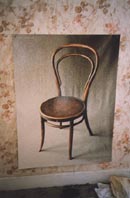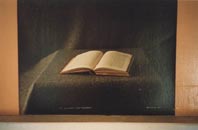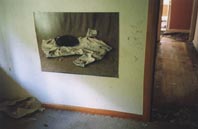|
  


Margaret Dawson
Where is she?Tales of travel and exploration.
Abandoned House
Contents:
1. "My Grandmother read biographies".
2. "Here she is!"
3. "Her scent has evaporated".
4. "Light".
5. Game
6. "We never looked into other women's handbags".
7. "Her suit's caved in".
8. "This isn't her chair".
9. Ashes
10. "I look like her?"
This exhibtion was first shown as part of the Journey's Project
in which Canterbury Women Artists celebrated Suffrage Centenary with
many local exhibitions and open studio days. My exhibition titled Where
is she? was shown at the old school house in Ferrymead Museum in
the recreated old township. The school is next to the Whitcomb and Tombs
printery and only reachable by catching a train. This printery held
the original machinery used to print out Kate Shepperd's suffrage pamphlets
in 1893. The isolated location of this historic park is similar to that
of Otira township. Being shown in out of town sites for only a short
period of time enhances that this is a fleeting impression, a faint
coonection to an earlier generation. There is a duality in the journey,
one to reach the exhibition and secondly an attempt to go back in time.
The title Where is she? suggests a search is going on within
these artworks for traces of women from the suffrage era. In particular
I started looking for a sense of my maternal grandmother, amongst old
familar objects. I placed the objects and clothing that may have been
hers in front of the camera. I had thought it would be easy as I have
such a clear picture of her in my head. It became more difficult to
convey any sense of her. I wanted to find out something more about her,
a sense, a trace, from these now abandoned objects. My Grandmother may
have worn these or used them.
There are ten artworks composed after the style of dutch still lifes.
In each photograph I have displayed mainly Victorian everyday objects.
The small mural size photographs are type C from colour negatives. Each
photograph is mounted onto canvas and laminated, mounted onto the wall
with nails through eyelets as if it is a painting. None of the backdrops
were suitable until I found an old blanket with colours of soft blue-grey
flecked with brown. This looked right metaphorically representing the
unknown or forgotten memories of past generations. The handwritten titles
on the photographic surface acknowleges the personal and intimate nature
of some of these domestic forms. This was a naivete in this search which
led to a sense of loss, an emptiness, like sniffing at a dead persons
clothing for a sense of them.
Domestic goods from every home sooner or later become rubbish and get
thrown out. Fortunately places like Ferrymead collect examples of items
used in the past and display them in a context for us to appreciate
and understand something of days gone by. I was interested in the idea
that without labels, without the personal associations, much of the
objects that we store may later discarded as rubbish.

|  |
|

